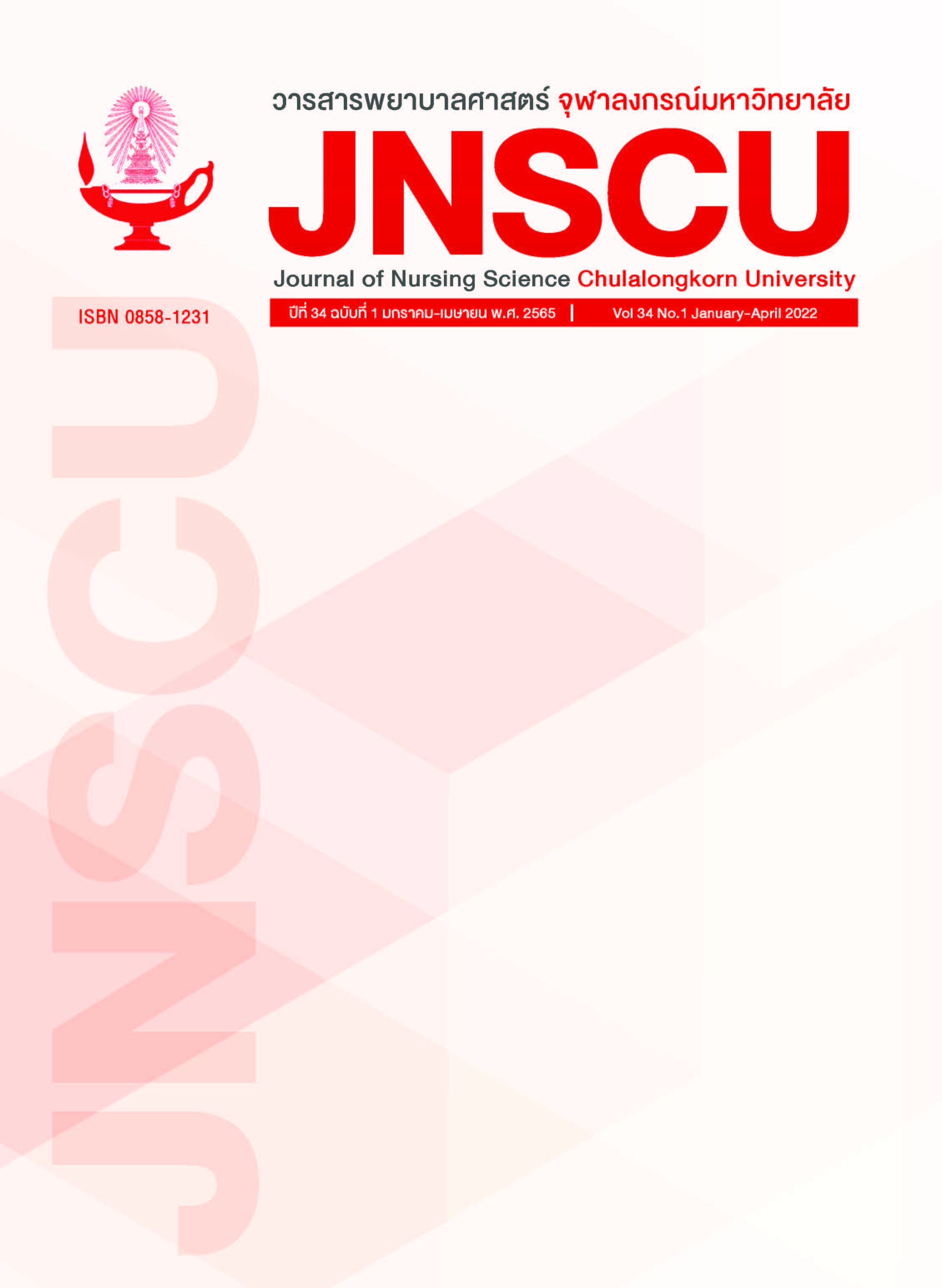ผลของโปรแกรมการกำกับอารมณ์ต่อความสามารถทางอารมณ์ และสังคมของเด็กที่มาจากครอบครัวหย่าร้าง
คำสำคัญ:
โปรแกรมการกำกับอารมณ์, ความสามารถทางอารมณ์และสังคม, เด็กที่มาจากครอบครัวหย่าร้างบทคัดย่อ
วัตถุประสงค์: เพื่อศึกษาผลของโปรแกรมการกำกับอารมณ์ต่อความสามารถทางอารมณ์และสังคมของเด็กที่มาจากครอบครัวหย่าร้าง
รูปแบบการวิจัย: การวิจัยกึ่งทดลอง
วิธีการดำเนินการ: กลุ่มตัวอย่าง คือ นักเรียนที่มาจากครอบครัวหย่าร้างที่กำลังศึกษาในโรงเรียนระดับประถมศึกษาปีที่ 4-6 คัดเลือกกลุ่มตัวอย่างตามเกณฑ์คัดเข้าจำนวน 60 ราย จากจังหวัดปทุมธานี แล้วสุ่มอย่างง่ายเข้ากลุ่มทดลองและกลุ่มควบคุม กลุ่มละ 30 ราย กลุ่มทดลองได้รับโปรแกรมการกำกับอารมณ์ ส่วนกลุ่มควบคุมได้รับการดูแลตามปกติ เครื่องมือที่ใช้ในการวิจัย คือ 1) โปรแกรมการกำกับอารมณ์ที่ผ่านการตรวจสอบความตรงตามเนื้อหา โดยผู้ทรงคุณวุฒิจำนวน 3 ท่าน 2) แบบประเมินความสามารถทางอารมณ์และสังคมที่ผู้วิจัยประยุกต์ขึ้นจากการทบทวนวรรณกรรม ซึ่งตรวจสอบความเที่ยงของแบบสอบถามได้ค่าสัมประสิทธิ์แอลฟาของครอนบาคได้เท่ากับ .89 วิเคราะห์ข้อมูลโดยใช้สถิติเชิงพรรณนาและสถิติทดสอบค่าที (t-test)
ผลการวิจัย: 1) เด็กที่มาจากครอบครัวหย่าร้างกลุ่มทดลองมีคะแนนความสามารถทางอารมณ์และสังคมหลังการทดลองสูงกว่าก่อนการทดลอง อย่างมีนัยสำคัญทางสถิติ และ 2) ผลต่างของค่าเฉลี่ยคะแนนความสามารถทางอารมณ์และสังคมระหว่างก่อนและหลังการทดลองของเด็กที่มาจากครอบครัวหย่าร้างกลุ่มทดลองสูงกว่ากลุ่มควบคุมที่ได้รับการดูแลปกติ อย่างมีนัยสำคัญทางสถิติ
สรุป: โปรแกรมการกำกับอารมณ์สามารถเพิ่มความสามารถทางอารมณ์และสังคมในเด็กที่มาจากครอบครัวหย่าร้างได้อย่างมีประสิทธิผล
เอกสารอ้างอิง
National statistical Office. Divorce registration
statistics [Internet]. 2018 [Cited 2019
March 10]. Available from: http://service.
nso.go.th/nso/web/statseries/
statseries02.html
Nunes-Costa RA, Lamela DJ, Figueiredo BF.
Adaptação psicossocial e saúde física em
crianças de pais separados. J Pediatr
, 85(5), 385-96.
Segal J. Dealing with a breakup or divorce
grieving and moving on after a relationship
ends [Internet]. 2017 [Cited 2019 January
. Available from: https://www.
helpguide.org/articles/grief/dealingwith-
a-breakup-or-divorce.htm
Eisenberg N, Spinrad TL, Eggum ND. Emotionrelated
self-regulation and its relation to
children’s maladjustment. Annu Rev Clin
Psychol 2010; 6: 495–525.
Stengård E, Appelqvist-Schmidlechner K.
Mental health promotion in young
people–an investment for the future.
Denmark: World Heal Organ; 2010.
Slee N, Spinhoven P, Garnefski N, Arensman
E. Emotion regulation as mediator of
treatment outcome in therapy for
deliberate self-harm. Clin Psychol
Psychother 2008; 15(4): 205–16.
Gross JJ, Jazaieri H. Emotion, emotion
regulation, and psychopathology: An
affective science perspective. Clin
Psychol Sci 2014; 2(4): 387–401.
Gross JJ. The emerging field of emotion
regulation: An integrative review. Rev Gen
Psychol 1998; 2(3): 271-99.
Gross JJ, Sheppes G, Urry HL. Cognition and
emotion lecture at the 2010 SPSP
emotion preconference: Emotion
generation and emotion regulation: A
distinction we should make (Carefully).
Cogn Emot 2011; 25(5): 765–81.
Fernandez KC, Jazaieri H, Gross JJ. Emotion
regulation: a transdiagnostic perspective
on a new RDoC domain. Cognit Ther Res
; 40(3): 426–40.
Gross JJ. Emotion regulation: Conceptual and
empirical foundations [Internet]. (Ed.)
IJJG, editor. Handbook of emotion
regulation. New York: NY, US: Guilford
Press; 2014.
Marashi F, Nikmanesh Z. The Effectiveness of
Emotion Regulation Training with a
Positive Thinking Approach in Quality of
Life and Its Dimensions Among Children
with Cancer. Jundishapur J Chronic Dis
Care 2018; 7(1): e61159.
Nilrat R, Jetjamnongnuch W. The development
of a social and emotional learning
program for fourth to sixth grade students
[Master’s thesis in of Education Program
in Educational Research and Psychology].
Bangkok: Chulalongkorn University; 2010.
Lertsrimongkol P, Wisetsuvarnabhumi P.
Effects of an emotional regulation training
program on teamwork skills of sixth grade
students [Master’s thesis in of Education
Program in Educational Research and
Psychology. Bangkok: Chulalongkorn
University; 2012.
Chubdari A, Rasuli M, Barzi HK. Effectiveness
of emotion regulation training on
reduction of symptoms in students
with oppositional defiant disorder. Int J
Emerg Ment Heal Hum Resil 2016; 18(1):
–5.
Dingle GA, Hodges J, Kunde A. Tuned in
emotion regulation program using music
listening: Effectiveness for adolescents
in educational settings. Front Psychol
; 7: 1-10.
Dunsmore JC, Booker JA, Ollendick TH.
Parental emotion coaching and child
emotion regulation as protective factors
for children with oppositional defiant
disorder. Soc Dev 2013; 22(3): 444–66.
ดาวน์โหลด
เผยแพร่แล้ว
ฉบับ
ประเภทบทความ
สัญญาอนุญาต

อนุญาตภายใต้เงื่อนไข Creative Commons Attribution-NonCommercial-NoDerivatives 4.0 International License.
ลิขสิทธิ์ของบทความที่ตีพิมพ์เป็นของวารสารพยาบาลศาสตร์ จุฬาลงกรณ์มหาวิทยาลัย ทั้งฉบับตีพิมพ์เป็นรูปเล่มและเอกสารออนไลน์



